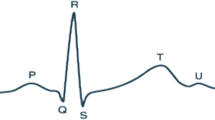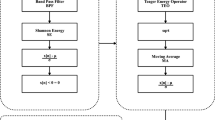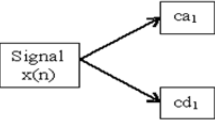Abstract
QRS detection for electrocardiogram (ECG) signal plays a fundamental role in monitoring cardiovascular diseases. Lots of QRS detection algorithms exist and most of them are verified with high sensitivity and positive predictivity on the standard ECG databases. Recent progress in mobile ECG rises the challenge of accurate QRS detection for real-time dynamic ECG recordings since the variety of noises. In this study, a decision-making fusion method for accurately locating QRS complexes from the multiple QRS detectors were proposed. First, the ECG signals were detected by these nine detectors. Then, the voting fusion rule had been established that a heartbeat was determined when more than five detectors showed their detections in a time moving window respectively. And the mean value of the middle three detections’ positions in the window was served as a corrected heartbeat. Moreover, the comprehensive post processing technology was used to eliminate the false detection and to search the missed beats. The new proposed method was tested on high and poor signal quality ECG databases. For comparison, the best detection accuracy for the single algorithm was only 75.50% while the new proposed fusion method with 200 ms time moving window reported a detection accuracy of 80.43% for the poor-quality ECG signals. The proposed fusion method can significantly improve locating QRS complexes accuracy for the ECG signals with poor signal quality. Thus, it has a potential usefulness in the real-time dynamic ECG monitoring situations.
Access provided by Autonomous University of Puebla. Download conference paper PDF
Similar content being viewed by others
Keywords
1 Introduction
Accurate heart rate detection for ECG signal plays a fundamental role in monitoring cardiovascular diseases (CVD), which has been the most common cause of death globally. The QRS complex is the most striking waveform within the Electrocardiogram (ECG) signal; it serves as the basis for the automated determination of the heart rate, as well as the benchmark point for classifying the cardiac cycle and identifying any abnormality. Lots of QRS detection algorithms exist and most of them are verified with high sensitivity and positive predictivity (>99%) on the open-access ECG database, such as MIT-BIH arrhythmia database [1].
Recently, the rapid development in wearable and telehealth technologies promotes the real-time, remote and continuous ECG individual monitoring. Real-time ECG remote monitoring is an effective means for the early warning of CADs. However, the quality of signals monitored by mobile devices also bring the new challenge. The subject of the PhysioNet/CinC Challenge 2011 was to develop an efficient algorithm to detect the quality of ECGs collected using mobile phones. Liu et al. [2] reported that the classical QRS detection method proposed by Pan and Tompkins [3] only had a relatively low detection accuracy on the low-quality ECG signals. Khamis et al. [4] developed new QRS detection method based on the artifact masking technology, which reported the good detection performance. The methods about locating QRS complexes on the low-quality signal was not insufficient. In this study, a decision-making fusion method for locating QRS complexes based on up to nine QRS detectors were proposed.
2 Methods
2.1 The Decision-Making Fusion Method
In this study, we proposed a new decision-making fusion method for accurately locating QRS complexes based on up to these nine QRS detectors, including RS-slope algorithm [5], Sixth-power algorithm [6], Finite State Machine algorithm (FSM) [7], U3 transform algorithm (U3) [8], Difference operation algorithm (DOM) [9], Pan and Tompkins algorithm (Pan) [3], ‘jqrs’ algorithm [10], UNSW algorithm (UNSW) [4], Optimized knowledge based algorithm (OKB) [1]. Figure 1 shows the flow diagram of the proposed decision-making fusion method.
First, the ECG signals were detected by nine detectors. Then, the voting fusion rule had been established that a heartbeat was determined when more than five detectors showed their detections in a time moving window respectively. Considering it is almost impossible that all detectors showed their detections at the same time, time moving window was introduced. The voting decision-making fusion rule was shown by Eqs. (1)–(3) defined as follows:
where, \( R_{i} \) was the QRS complexes location detected by the nine QRS detectors, i = 1, 2, 3, …, 9; \( {\text{w}}_{j} \) was the time moving window for the voting and was set as 50 ms, 100 ms, 150 ms, 200 ms and 250 ms respectively in this study; \( {\text{V}}\left( {{\text{w}}_{j} } \right) \) represented the voting result of these nine detectors in the \( {\text{w}}_{j} \) window. if \( {\text{V}}\left( {{\text{w}}_{j} } \right) \ge 5 \), \( {\text{S}}\left( {\text{j}} \right) \) was equaled to one, and this time moving window \( {\text{w}}_{j} \) was regarded as a potential heartbeat. Then the first R wave detected point outside the current window on the right side was regarded as the next time window left side. Otherwise, \( {\text{S}}\left( {\text{j}} \right) \) was equaled to zero, and this time moving window \( {\text{w}}_{j} \) was rejected, and the first (and left-most) R wave detected point inside the current window was given up, and the second point regarded as the next time window left side. And the mean value of the middle three detections’ positions in each selected time window was served as a corrected QRS complexes position. The position of maximum absolute value was located as R wave points the in a window of 100-ms.
Then, the post-processing technology was applied to eliminate the possibility of a false detection and search the missed beats. First, the standard RR interval was determined as the median value of 70% central range of RR-interval series. And the search threshold was determined as 0.6 times the mean value of 50% central range of R waves value. If the current RR interval was larger than the 1.66 times the standard RR interval, the search threshold was used to find new peaks as the new heart beats. If the current RR interval was smaller than the 0.6 times the standard RR interval, the search threshold was used to eliminate the false detection. Moreover 270 ms blind-eye window was employed to avoid the oversized T waves to be taken as detections.
2.2 Database
For the comparison, two databases were selected from the PhysioNet/CinC Challenge 2014 [11]. One was the training set with good signal quality, consisted of single II-lead 100 recordings (named 100–199), sampled at 250 Hz, with 12-bit resolution. This database was used as the high-quality ECG database in this study. Another one was an augmented training set with very low quality also consisted of 100 recordings, sampled at 360 Hz. This database was used as low-quality database in this study. Each recording had a 10 min in duration. All ECG recordings had the manually annotated QRS complex locations and these locations were used as the references for evaluating the four automatic QRS detection algorithms.
2.3 Evaluation Methods
The evaluation metrics of sensitive (Se), positive predictivity (+P) and F1 measure were calculated as follows:
where TP is the number of QRS complexes truly detected, FP is the number of false positive (extra falsely detected QRS complexes) and FN is the number of false negative (missed detected QRS complexes).
3 Results and Discussion
Tables 1 and 2 show the performances of nine single QRS detectors and the proposed fusion method on the high and poor signal quality ECG databases, respectively. All these ten methods had good detection results for the high signal quality ECG database (all >99%, shown in Table 2). However, the detection results decrease significantly for the poor signal quality ECG signals. The best detection accuracy for the nine single algorithms was only 75.50% from the OKB method, while the new proposed fusion method with 200 ms time moving window reported a detection accuracy of 80.43%.
For these two databases, compared with these nine QRS detection methods, the new fusion method all reported the best performance. For the high signal quality database, although the fusion method showed the best the detection results, the nine single QRS detectors all had high detection accuracy (all >99%). In this way, considering the computational efficiency, it was no need to use fusion method to pursue a little improvement on the detection accuracy.
However, for the poor signal quality database, the new fusion method with 200 ms time moving window reported higher detection accuracy (80.43%) compared with the nine single QRS detectors (all <75.5%). Figure 2 shows an example from the recording 1019 in the poor signal quality ECG database. The red crosses represent the reference annotations, and the magenta asterisks represent the detected points of nine single QRS detectors, and the green asterisks represent the detected points of the new fusion method. Different QRS detectors had different robust performance for different noise. This figure illustrates that voting fusion rule could extract the best R wave points from nine QRS detectors detection results, which can improve noise immunity. And the comprehensive post processing technology could eliminate the false detection and search the missed beats, which improves the detection accuracy further. The influence of the time moving window width was not obvious for the high signal quality ECG database. For the poor signal quality ECG database, 200 ms time window showed the best performance.
4 Conclusion
In this study, a new decision-making fusion method for QRS complexes location based on up to nine QRS detectors were proposed. High and poor ECG signal quality databases were used to analyze the performance of this new method. For these two databases, compared with these nine QRS detection methods, the new fusion method all reported the best performance. Especially for the poor-quality ECG signals, this fusion method with 200 ms time moving window reported higher detection results (F1 = 80.43%), while the best detection accuracy for the single algorithm was only 75.50%.
The proposed fusion method can significantly improve the QRS detection accuracy for the ECG signals with poor signal quality. Thus, it has a potential usefulness in the real-time dynamic ECG monitoring situations.
References
Elgendi, M.: Fast QRS Detection with an Optimized Knowledge-Based Method: Evaluation on 11 Standard ECG Databases. Plos One 8, e735571–735518 (2013).
Liu, F., Wei, S., Li. Y., Jiang, X., Zhang, Z., Zhang, L., Liu, C.: The accuracy on the common Pan-Tompkins based QRS detection methods through low-quality ECG database. Journal of medical Imaging and Health Informatics 7(5), 1039–1043 (2017).
Pan, J., Tompkins, W.: A real-time QRS detection algorithm. Biomedical Engineering, IEEE Transactions on bio-medical engineering 32(3), 230–236 (1985).
Khamis, H., Weiss, R., Xie, Y., Chen, C., Lovell, N., Redmond, S.: QRS Detection Algorithm for Telehealth Electrocardiogram Recordings. IEEE Transactions on Biomedical Engineering 63(7), 1377–1388 (2016).
Podziemski, P., Gieraltowski, J. Fetal heart rate discovery: algorithm for detection of fetal heart rate from noisy, noninvasive fetal ECG recordings. In: Computing in Cardiology Conference 2013, vol. 40, pp. 333–336. IEEE, Zaragoza (2013).
Dohare, A., Kumar, V., Kumar, R., An efficient new method for the detection of QRS in electrocardiogram. Computers & Electrical Engineering 40(5), 1717–1730 (2013).
Gutierrez-Rivas, R. Garcia, J., Marnane, W., Hernandez, A.: Novel Real-Time Low-Complexity QRS Complex Detector Based on Adaptive Thresholding. IEEE Sensors Journal 15(10), 6036–6043 (2015).
Paoletti, M., Marchesi, C.: Discovering dangerous patterns in long-term ambulatory ECG recordings using a fast QRS detection algorithm and explorative data analysis. Computer Methods & Programs in Biomedicine 82(1), 20–30 (2006).
Yeh, Y., Wang, W., QRS complexes detection for ECG signal: The Difference Operation Method. Computer Methods and Programs in Biomedicine 91(3), 245–254 (2008).
Behar, J., Oster, J., Clifford, G.: Non-invasive FECG extraction from a set of abdominal sensors. In: Computing in Cardiology Conference 2013. pp. 297–300. IEEE, Zaragoza (2013).
Silva I., Moody B., Behar J., Johnson A., Oster J., Clifford G.D., Moody G.B., Robust detection of heart beats in multimodal data, Physiological Measurement 36, 1629–1644 (2015).
Acknowledgements
The study was partly supported by the National Natural Science Foundation of China (Grant Number: 61571113 and 61671275), the Key Research and Development Programs of Jiangsu Province (Grant Number: BE2017735). The authors thank the support from the Southeast-Lenovo Wearable Heart-Sleep-Emotion Intelligent monitoring Lab.
Author information
Authors and Affiliations
Corresponding author
Editor information
Editors and Affiliations
Ethics declarations
The authors declare no conflict of interest.
Rights and permissions
Copyright information
© 2019 Springer Nature Singapore Pte Ltd.
About this paper
Cite this paper
Liu, F. et al. (2019). A Decision-Making Fusion Method for Accurately Locating QRS Complexes from the Multiple QRS Detectors. In: Lhotska, L., Sukupova, L., Lacković, I., Ibbott, G. (eds) World Congress on Medical Physics and Biomedical Engineering 2018. IFMBE Proceedings, vol 68/2. Springer, Singapore. https://doi.org/10.1007/978-981-10-9038-7_66
Download citation
DOI: https://doi.org/10.1007/978-981-10-9038-7_66
Published:
Publisher Name: Springer, Singapore
Print ISBN: 978-981-10-9037-0
Online ISBN: 978-981-10-9038-7
eBook Packages: EngineeringEngineering (R0)






